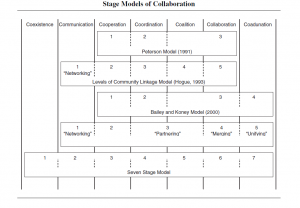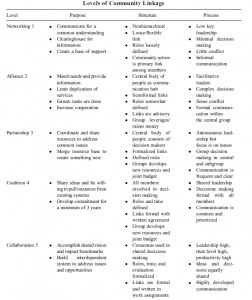Opioid-involved overdose deaths in the US quadrupled in number over the last sixteen years and now cost the nation over $500 billion a year. (Council of Economic Advisors, 2017) To help address this crisis, federal and state policymakers are urging for increased collaboration across the substance abuse treatment, healthcare, social service, and criminal justice sectors. However, it is no simple task to increase collaboration in ways that will be meaningful. One of the many barriers to promoting effective, cross-sector collaboration is a lack of knowledge about which organizations are relevant to the opioid crisis, which are already collaborating, which are not collaborating, and why. To help address this barrier, the Polis Center is prototyping ways to assist local leaders and policy makers in gaining this essential knowledge.
As part of this effort, it is essential to adopt a standard language for discussing and classifying the types of interorganizational relationships that local organizations have established. Researchers and program evaluators have developed different models to describe the level(s) of collaboration that exists between organizations. (Figure 1)

Figure 1: Source: (Frey, Lohmeier, Lee, & Tollefson, 2006)
Several models, such as that shown in Figure 2, use the associated goal(s), structure, and/or processes of an interorganizational collaboration to classify the level of collaboration. Based on the input of local organizations, Polis has selected and is testing the use of the Levels of Community Linkage Model.(Hogue, 1993) This model includes five levels of collaboration (in increasing order): Networking, Cooperation, Coordination, Coalition, and Collaboration. By testing the ease with which organizations can classify their interorganizational relationships, we will determine whether this model, or an adapted version, will be helpful in developing a local knowledgebase about the network of organizations addressing the opioid crisis.

Figure 2: Source: (Cross, Dickmann, Newman-Gonchar, & Fagan, 2009)
References:
Council of Economic Advisors. (2017). Council of Economic Advisers Report: the Underestimated Cost of the Opioid Crisis. Retrieved April 28, 2019, from The White House website: https://www.whitehouse.gov/briefings-statements/cea-report-underestimated-cost-opioid-crisis/
Cross, J. E., Dickmann, E., Newman-Gonchar, R., & Fagan, J. M. (2009). Using Mixed-Method Design and Network Analysis to Measure Development of Interagency Collaboration. American Journal of Evaluation, 30(3), 310–329. https://doi.org/10.1177/1098214009340044
Frey, B. B., Lohmeier, J. H., Lee, S. W., & Tollefson, N. (2006). Measuring Collaboration Among Grant Partners. American Journal of Evaluation, 27(3), 383–392. https://doi.org/10.1177/1098214006290356
Hogue, T. (1993). Community-based collaboration: Community wellness multiplied. Oregon Center for Community Leadership, Oregon State University.
Substance Abuse and Mental Health Services Administration (SAMHSA), O. of the S. G. (US). (2016). HEALTH CARE SYSTEMS AND SUBSTANCE USE DISORDERS. Retrieved from https://www.ncbi.nlm.nih.gov/books/NBK424848/
[NOTE: The Polis Center is working with the State of Indiana’s Management Performance Hub (MPH) as part of the Indiana Data Partnership (IDP). The IDP was formed as an enhancement to the MPH mission by creating a replicable, sustainable framework that helps additional local and non-governmental organizations successfully partner to maximize holistic solutions and minimize duplication of efforts through sharing and viewing common data. (MPH provides data analytics solutions tailored to address management and policy questions enabling improved outcomes for Hoosiers.) Funded through the Lilly Endowment, other initial partners include the IU Public Policy Institute (PPI) and the Indiana Business Research Center (IBRC). Additional partners and focus areas will be added as the initiative progresses.
This pilot project is initially focused on education and workforce initiatives and combating the opioid epidemic. Polis is focusing on the opioid crisis part of the project, integrating data from the SAVI community information system with those managed by the IBRC for a more comprehensive inventory of organizations than has ever been realized within the State of Indiana. Combining this inventory opens greater possibilities for information discovery and problem solving.
Through this data partnership, the public will have greater access to data than ever before, increasing their ability to build stronger and more prepared communities and to more quickly recover from disasters of all types – natural, economic, and health to name a few. Communities will be better prepared with the knowledge of the resources that can be brought to bear, providing information about potential collaborators, sharing the importance of wrap around services for individuals and families impacted, and engaging stakeholders in conversations about possible solutions.–Allegra East, Polis Communications Manager]

